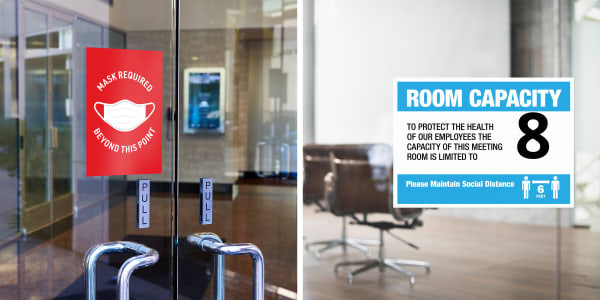4 Post-Pandemic Office Trends on the Radar of Business Leadership
How the response to COVID-19 is shaping the way we’re returning to work in 2021
COVID-19 forced the world to change the way it does business. Everything we knew (or thought we knew) about productivity, team-building and social capital was turned on its head as employees and business leadership rose to the occasion of adapting during crisis.
As more businesses and public spaces open back up, business leaders must decide what the “new normal” will look like for employees returning to work in the office. Right now there is an extraordinary opportunity for thought leaders to revamp and revitalize how their team will work going forward.
These are the top 4 office trends to keep on your radar as you plan for transitioning your team from remotely to working in person (or something in between).
1) The rise of the hybrid office: greater flexibility and communication
From creating a new work-life balance and carving out home office space, to our kids making surprise cameos on Zoom, there have certainly been challenges over the past year. However, despite the learning curve, most Americans would prefer to work from home going forward, at least part time.
Which is not a bad thing, since productivity actually increased while the workforce was remote. Not to mention that communication skills honed during the pandemic (including proficiency in Slack, Microsoft Teams, Zoom, etc.), can keep the social capital tap flowing even while working remotely.
Now that the workforce, in general, has “leveled-up” on communication skills, employees are primed to make smooth transitions between in-person and remote work. The key for business leaders will be to balance the increased productivity and flexibility of remote work with the benefits of working in person.
What a hybrid office looks like (where employees split time working from home and in person) is the question that seems to be on everyone’s mind. Managers and other business leaders will be considering mandatory days, staggered remote days and other ways to capitalize on the “best of both worlds.”

Mask requirement signs and other COVID safety signage will remain essential for maintaining policies that reduce the spread of germs.
2) Rearranging procedures and spaces to help employees stay healthy
Although the most severe days of the pandemic may be behind us, COVID-19 is not eradicated. Nor do scientists expect it to be any time soon. Reducing the spread of germs will be an essential part of workplace management for quite some time.
Mask requirements, reduced capacity in meeting and break areas, social distancing and the use of physical barriers (such as plexiglass) will continue to trend in 2021 and beyond. Business leadership will continue to encourage employees who are sick to stay at home.
Many written policies put into place by companies during the pandemic asking (if not requiring) employees to stay home when sick and/or contagious will stay in place. Procedures developed for working remotely will help maintain productivity and empower employees to stay home when needed.
Communication Confidence:
- Free customizable sign templates for printing your own DIY removable wall decals
- Custom printed COVID wall decals & durable vinyl social distancing floor decals
- Self-adhesive social distancing table & chair signs that won't damage surfaces
3) New prioritization of mental health, empathy and compassion
The coronavirus pandemic has been an extraordinary time for exploring alternatives to the classic American working model. Collectively, we’ve learned a great deal about how we work, better communication and resilience in the face of adversity.
Collectively, we’re also grappling with enormous trauma and loss. The implications of COVID-19 on mental health (from anxiety and depression to unhealthy alcohol and/or substance use) will continue to affect the workforce post-pandemic. Prioritizing mental health will be crucial for business recovery.
At the top of the pandemic, empathy and compassion moved proactive leaders to ensure employees were aware of/had access to company-supported mental health services. This trend will continue, with many expanding to include onsite mental health professionals and HR roles focused on well-being.
4) Increasing workforce potential by capitalizing on what we learned in 2020
Now that we know that employees are more productive while working from home (and have a preference for more remote work in general) leaders must ask why this is the case. Having more control over how time is spent and how work is accomplished are two major factors.
Employees working from home during the pandemic had more control over their time and spent less time wasted on commutes and other in-office interruptions. For example, unnecessary meetings were all but eliminated as limited meeting capacity required hosting more effective and focused.
Limited resources during the height of the pandemic also required many employees to reach beyond their current roles and tasks. Employees were able to make decisions about how work was accomplished, often tapping into personal passions and interests in order to meet the needs of the business.
Moving forward in 2021, it will benefit organizations to continue to capitalize on the unforeseen workforce potential unleashed during the pandemic. Business leaders will be looking for more opportunities that allow both employees and the organization to thrive long term.
Taking the lead returning to work in a post-pandemic office
It turns out that completely disrupting the way we work for an entire year was an amazing learning opportunity for employees and leadership alike. Out-dated notions of rigid working hours and remote work lacking productivity are gone.
Whether your company is returning to work in an office full time, staying remote or embracing the era of the hybrid office, one thing is clear. Employers, managers and employees alike are all moving forward with a renewed appreciation for flexibility and adaptability.
What do you envision for your team in a post-pandemic office? Connect with us on LinkedIn or Facebook and share your thoughts.